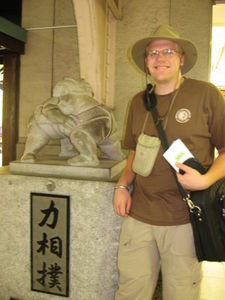Advertisement
Published: September 29th 2007

 Me and Sumo wrestlers
Me and Sumo wrestlers
This is me dwarfing two Sumo wrestlers.I wanted to grab a bite to eat at a local inexpensive restaurant the other night. Fortunately, I found one next to the guesthouse I was staying at. The dishes they served, each with its price were pictured on the outside wall. Unfortunately, the door was difficult for me to find. The door I went in led me up a tight wooden stairway. When I got to the top I could hear the thump of dance music coming from behind the door. I thought it was strange, but went in the door anyway. Once inside the room I saw that there was a disco ball and mood lighting to go with the dance music. A woman approached me looking stunned. I asked if I could get something to eat. She looked confused, then ran to the phone and made a quick call. While she was talking I looked around the room and saw that there were about a dozen two person tables, but none that would seat any more than two people. When the woman came back she was very apologetic and informed me that they couldn’t help me. It was a strange and awkward goodbye as she kept apologizing and

 Sumo Stadium
Sumo Stadium
This is the outside of the Sumo StadiumI kept grinning stupidly and assuring it was perfectly fine. The goodbye was made even more awkward when I missed the first step and slid down the first four or five steps on my butt. She ran after me to help me up. I assured her that I was perfectly fine and rushed down the rest of the stairs and out the door. Back on the street I noticed a sign in front of the door I had just emerged from. I couldn’t read it, but all the neon hearts flashing gave me the impression it wasn’t a restaurant I was just in. Okay, so I almost got involved some kind of Japanese love connection on my second night in Tokyo. So what?
I tried the next door over and it turns out that was the restaurant I was looking for all along. I placed my order without much fanfare and eagerly awaited my sweet and sour pork while watching a Japanese game show alongside two older men. They thought it was pretty interesting. I was uninterested. When my meal came I noticed that she brought me chopsticks. I knew this moment would come. The moment when the waitress

 Sumo Stadium 2
Sumo Stadium 2
Outside of Sumo Stadiumforgets that I am obviously a helpless foreigner whose woeful inability to use chopsticks will cause everyone embarrassment. Or maybe, she is just polite and doesn’t make assumptions. Either way I was faced with the dilemma (or shall I call it opportunity?) to try the sticks once again. I have tried chopsticks once or twice before and the experience was an utter failure. In fact, the last time I tried to use chopsticks I turned my eating utensils into wooden shanks by stabbing the morsels of meat on my plate. I remembered from my Lonely Planet book that the Japanese would be offended by this particular way of using the chopstick because it is the customary way to offer food to the dead. I resolved to use the chopsticks the old fashioned way, no matter how long it took. The first thing that happened when I tried to use my chopsticks was I got a splinter- an ominous beginning. What followed was a circus of food and soy sauce on my plate and before I knew it the men had turned from their Japanese game show and had focused on me. It wasn’t long before one of them called the

 Meiji Jinju
Meiji Jinju
During the Meiji Era (1868-1912) Japan flourished under the benign rule of Emperor Meiji, who promulgated the Meiji Constitution, promoted friendship with foreign countries, and developed the nation in every cultural field. It was one of the most glorious and prosperous period of all the Japanese history of more than 2,000 years. It was the period when the bases of modern Japan were built up. It was Emperor Meiji who, as the leader of this colourful early modern period of Japanese history, devoted himself wholeheartedly to increase the prosperity and peace of the nation and those of the world. Consequently, Emperor Meiji was regarded as a truly great Emperor not only by Japanese but also foreigners. Empress Shoken assisted the Emperor behind the scenes during this eventful and difficult Meiji Period, and was lauded as the model of the Modern Japanese Woman. The demise of the Emperor was on 30th July in 1912, and that of the Empress on 11th April in 1914. The wish of the Japanese nation to commemorate their illustrious lives generated a movement to create a shrine. The building was completed in 1920, but was lost by the fires during the World War II> The reconstruction of the present shrine building was completed in october 1958, being supported by all loyal Japanese both in Japan and abroad. (Text Taken from "Meiji Jinju" pamphlet. Published by Meiji Jingu Office, Yoyogi Shibuya-Ku, Tokyo. 2006)waitress over and said a few words. Next thing I know she is apologizing and handing me a fork. Mercifully, my struggles were over and I quickly devoured the rest of my meal, with both men eagerly smiling at my every bite.
Advertisement
Tot: 0.045s; Tpl: 0.01s; cc: 6; qc: 44; dbt: 0.0233s; 1; m:domysql w:travelblog (10.17.0.13); sld: 1;
; mem: 1.1mb

 Me and Sumo wrestlers
Me and Sumo wrestlers
 Sumo Stadium
Sumo Stadium
 Sumo Stadium 2
Sumo Stadium 2
 Meiji Jinju
Meiji Jinju
